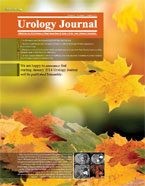Mini-Laparoscopic Live Donor Nephrectomy: Initial Series
Urology Journal,
Vol. 10 No. 4 (2013),
4 January 2014
,
Page 1054-1058
https://doi.org/10.22037/uj.v10i4.2299
Abstract
Abstract
Purpose: To present the safety and surgical outcomes of the initial series of mini-laparoscopic live donor nephrectomy and graft outcomes in related recipients.
Materials and Methods: From January 2012 through July 2012, fifty patients underwent mini-laparoscopic live donor nephrectomy. Two 3.5 mm trocars were inserted above and lateral to the umbilicus for grasping and scissoring. One 5 mm trocar with a camera was inserted in the umbilicus and an 11 mm trocar was inserted through fascia from a 6-8 cm Pfannenstiel incision for bipolar coagulation, kidney extraction, and vascular clip applier.
Results: Mean age of donors was 28 ± 4.2 (range, 21-39) years. Mean operative time from trocar insertion was 145.8 (range, 85-210) minutes. No major perioperative or postoperative complications occurred. The average decrease in hemoglobin level was 1.14 (range, 0.32-1.8) mg/dL and no one required blood transfusion. Mean warm ischemia time was 4.41 (range, 2.35-9) minutes. Mean hospital stay was 2.2 (range, 2-5) days. Mean follow-up time of the recipients was 215 (range, 130-270) days. The mean serum creatinine level of the recipients at discharge time and the last follow-up visit was 1.38 mg/dL and 1.22 mg/dL, respectively.
Conclusions: While the primary purpose of this technique is to make donor nephrectomy less invasive and more cosmetic, it is also comfortable for the laparoscopist surgeons because it is nearly similar to standard laparoscopy. A randomized controlled trial with a large sample size, long-term follow-up, and comparison with standard laparoscopy are necessary to present more definitive data about this technique.
How to Cite
- Abstract Viewed: 306 times
- PDF Downloaded: 220 times
